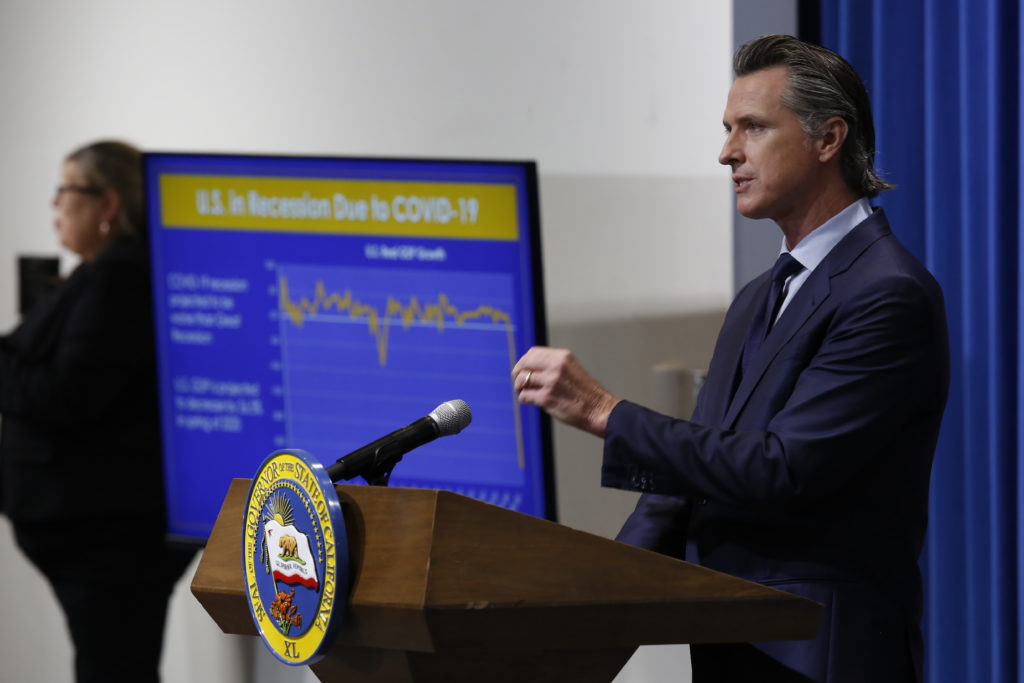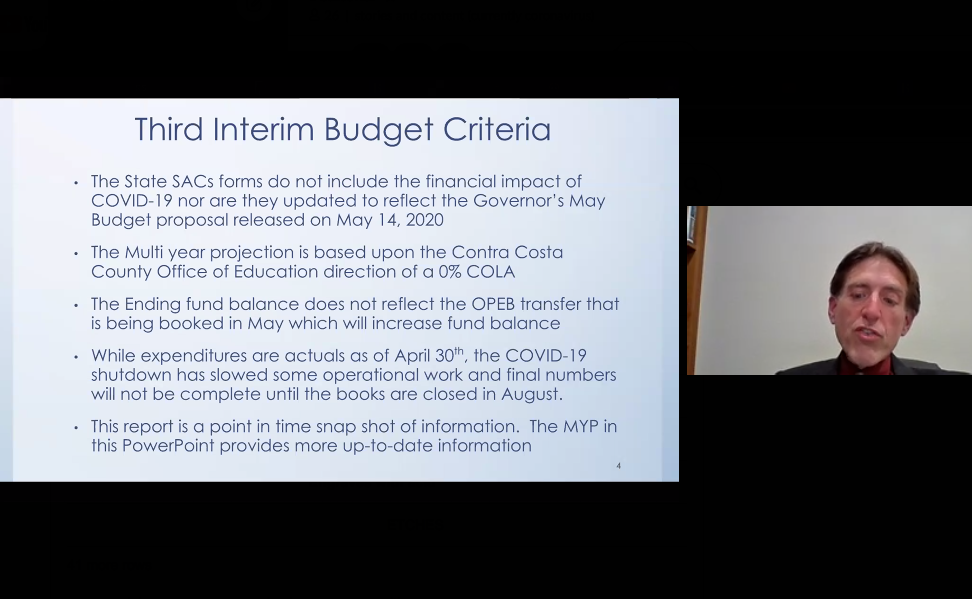
Black teachers: How to recruit them and make them stay

Lessons in higher education: What California can learn

Keeping California public university options open

Superintendents: Well-paid and walking away

The debt to degree connection

College in prison: How earning a degree can lead to a new life

The financial fallout from the coronavirus is threatening the budgets of all California schools, but cash-strapped districts like West Contra Costa Unified may be hit the hardest.
The district was already spending beyond its means prior to COVID-19, and estimated it had a projected deficit of $48 million by 2022. To reduce the projected deficit, it cut around $30 million from next school year’s budget in February, a move that required teacher and staff layoffs. It aimed to cut the remaining $18 million from the budget for the 2021-2022 school year. But now with funding shortfalls on the horizon and higher costs due to the pandemic, district officials fear that more difficult choices are ahead.
California Education Code requires school districts to adopt balanced budgets each year in June, which must be approved by their local county office of education. If a district is unable to meet its financial obligations while maintaining state-mandated reserve levels, state administrators could take over its finances, forcing their own cuts on the district.
West Contra Costa Unified is not alone in this predicament, said California School Boards Association spokesman Troy Flint. The organization conducted a survey in February and found that even then, 77% of districts were on course to deficits by the end of the school year.
“Districts of all sizes are feeling the pressure,” Flint said. “There’s going to be an impact on services and programs districts can provide, but once you cut back in those areas you’re faced with the possibility of layoffs, which also has a detrimental impact on students. It’s not just disadvantageous to employees, it affects students and communities as well.”
In addition to existing deficits, districts face twin problems caused by the coronavirus — higher costs and funding shortfalls.
School district expenses have shot up during the pandemic. In a May 18 letter to legislators, officials from six urban districts said they’ve already incurred extra costs this year as they shifted to distance learning. These included providing laptops to students, serving meals to families and providing personal protective equipment to staff. There’s also the added costs of expanding summer programs and potentially re-opening in the fall while following safety guidance.
West Contra Costa Unified officials, at a May 20 school board meeting, said they are still calculating the total cost of transitioning to digital learning March 16. Like districts throughout the state, they’re also waiting on guidelines from the state before planning how to open in the fall.

West Contra Costa Unified Chief Business Officer Tony Wold presents the district’s third interim budget report at a school board meeting May 20.
The situation is grim on the revenue side, as well. Like the whole country, California’s economy has been plunged into recession by the coronavirus. That’s sharply reduced the state’s revenues, at least 40% of which go to public schools. Even though Gov. Gavin Newsom tried to lessen the impact of the shortfall in his May 14 budget proposal, the Local Control Funding Formula — which accounts for 80% of the state funding for K-12 schools — will still take a $6.5 billion hit. All districts would receive a 10% cut in state funding. In addition, Newsom proposed doing away with a 2.3% cost-of-living adjustment that districts were banking on at the start of the year.
These cuts could be prevented if Congress passes the HEROES Act — a $3 trillion federal stimulus bill for states, cities and counties. The bill passed in the House, but faces dim prospects in the Republican-controlled Senate.
West Contra Costa Unified’s chief business officer Tony Wold said that, even under a best-case scenario that included HEROES funding, the district would be stuck cutting a total of more than $24 million from its budget for the 2021-2022 school year.
But if the HEROES Act does not pass and the district faces the reduction in the Local Control Funding Formula, the district would need to cut $41 million in the 2021-2022 school year.
Still, Wold urged the school community to stay calm.
“There still is a pathway for us. We will absolutely be able to be a viable school district next school year even under the worst case scenario,” Wold said at the May 20th school board meeting. “Because of the leadership of this board, of the cabinet, of the community to make the cuts that we needed to do we positioned ourselves to survive the first year of the single worst-impacted budget in the history of California schools.”
The district “will look at all possible options to make reductions,” which would be negotiated with its labor unions, Wold told Edsource. The district will “allow the government to move through the political process over the next couple of months” in order to determine how much financial help will be available. Then it will meet with local stakeholders before deciding how the cuts would be made.
If the district must make $41 million in cuts to its budget, it would end the 2021-2022 school year with a financial reserve of $14.7 million, satisfying state requirements for a district of that size. If the district doesn’t meet its budget-cutting target, it will be “in the red,” Wold said, since it would have drained all of its reserve funds. At that point, the district would risk state takeover.
“Every dollar that we get in federal aid, every dollar that we don’t spend, will reduce that cut target for 21-22,” Wold said. “So we have an entire year to advocate and work through to make a difference.”
Demetrio Gonzalez, president of the United Teachers of Richmond, said the teachers union has met with both House Speaker Nancy Pelosi and Governor Gavin Newsom’s staff to advocate for more funding for the district. Gonzalez said the union stressed to Newsom’s staff how profound the impact of the proposed cuts would be on West Contra Costa Unified and other urban districts.
Both the United Teachers of Richmond and the district plan to step up their advocacy for the Schools and Communities First initiative. The November ballot measure would alter Prop 13 to raise taxes on most commercial property, and is estimated to raise $12 billion annually for school districts and local governments.
If the initiative were to pass, it would soften the blow of the state budget cuts to West Contra Costa Unified.
East Bay state Assemblywoman Buffy Wicks, whose district encompasses West Contra Costa Unified, told EdSource that the initiative would directly respond to the financial crisis faced not only by schools but social safety net programs as well.
“These investments in our schools and communities were essential before the pandemic — now, particularly in light of the State’s seismic budget deficit, they’re a lifeline we simply can’t go without,” Wicks said.
Staff writer John Fensterwald contributed to this report.

A bill to mandate use of the method will not advance in the Legislature this year in the face of teachers union opposition.

Nearly a third of the 930 districts statewide that reported data had a higher rate of chronic absenteeism in 2022-23 than the year before.

The move puts the fate of AB 2222 in question, but supporters insist that there is room to negotiate changes that can help tackle the state’s literacy crisis.

In the last five years, state lawmakers have made earning a credential easier and more affordable, and have offered incentives for school staff to become teachers.
Comments (2)
Comments Policy
We welcome your comments. All comments are moderated for civility, relevance and other considerations. Click here for EdSource's Comments Policy.
tomm 4 years ago4 years ago
As I recall, the District narrowly avoided a teachers strike last year and agreed to pay raises exceeding 20% over 3 years? Something like that. This would have resulted in a depletion of reserves further exasperating the budget shortfall. Same thing happened in other school Districts, e.g. San Ramon Valley Unified, but not in others. Those Districts that held strong against union demands are looking good, congratulations. Please include this in … Read More
As I recall, the District narrowly avoided a teachers strike last year and agreed to pay raises exceeding 20% over 3 years? Something like that. This would have resulted in a depletion of reserves further exasperating the budget shortfall.
Same thing happened in other school Districts, e.g. San Ramon Valley Unified, but not in others. Those Districts that held strong against union demands are looking good, congratulations. Please include this in your reporting so the readers are informed.
marco 4 years ago4 years ago
I hope districts aren't counting too much on Schools and Communities First revenue to fix their 2020-21 and 2021-22 budget shortfalls. The plain language of the measure acknowledges that it will take several years to reassess all commercial properties to market and acknowledges that there will be appeals. I suppose the Legislature could try to speed things up by decreeing temporary interim "market" assessments according to a simplified formula, but that would surely end up … Read More
I hope districts aren’t counting too much on Schools and Communities First revenue to fix their 2020-21 and 2021-22 budget shortfalls. The plain language of the measure acknowledges that it will take several years to reassess all commercial properties to market and acknowledges that there will be appeals. I suppose the Legislature could try to speed things up by decreeing temporary interim “market” assessments according to a simplified formula, but that would surely end up in court, with its own delays. Schools & Communities First may be the right thing for California, but it’s no panacea for the COVID-19 fiscal crisis facing school districts and local government.